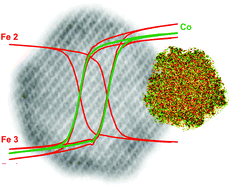Strong interfacial coupling through exchange interactions in soft/hard core–shell nanoparticles as a function of cationic distribution†
Abstract
Exchange coupled core–shell nanoparticles present high potential to tune adequately the magnetic properties for specific applications such as nanomedicine or spintronics. Here, we report on the design of core–shell nanoparticles by performing the successive thermal decomposition of Fe and Co complexes. Depending on the thermal stability and the concentration of the Co precursor, we were able to control the formation of a hard ferrimagnetic (FiM) Co-ferrite shell or an antiferromagnetic (AFM) CoO shell at the surface of a soft FiM Fe3−δO4 core. The formation of the Co-ferrite shell was also found to occur through two different mechanisms: the diffusion of Co or the growth at the iron oxide surface. The structural properties of core–shell nanoparticles were investigated by a wide panel of techniques such as HAADF, STEM and XRD. The distribution of Fe and Co elements in the crystal structure was described accurately by XAS and XMCD. The operating conditions influenced significantly the oxidation rate of Fe2+ in the core as well as the occupancy of Oh sites by Fe2+ and Co2+ cations. The structural properties of nanoparticles were correlated with their magnetic properties which were investigated by SQUID magnetometry. Each core–shell nanoparticle displayed enhanced effective magnetic anisotropy energy (Eeff) in comparison with pristine Fe3−δO4 nanoparticles because of magnetic coupling at the core–shell interface. The Co-ferrite FiM shells resulted in better enhancement of Eeff than a CoO AFM shell. In addition, the magnetic properties were also influenced by the core size. The coercive field (HC) was increased by core reduction while the blocking temperature (TB) was increased by a larger core. Element-specific XMCD measurements showed the fine coupling of Fe and Co cations which agree with Co-ferrite in each sample, e.g. the formation of a Co-doped interfacial layer in the Fe3−δO4@CoO nanoparticles.



 Please wait while we load your content...
Please wait while we load your content...